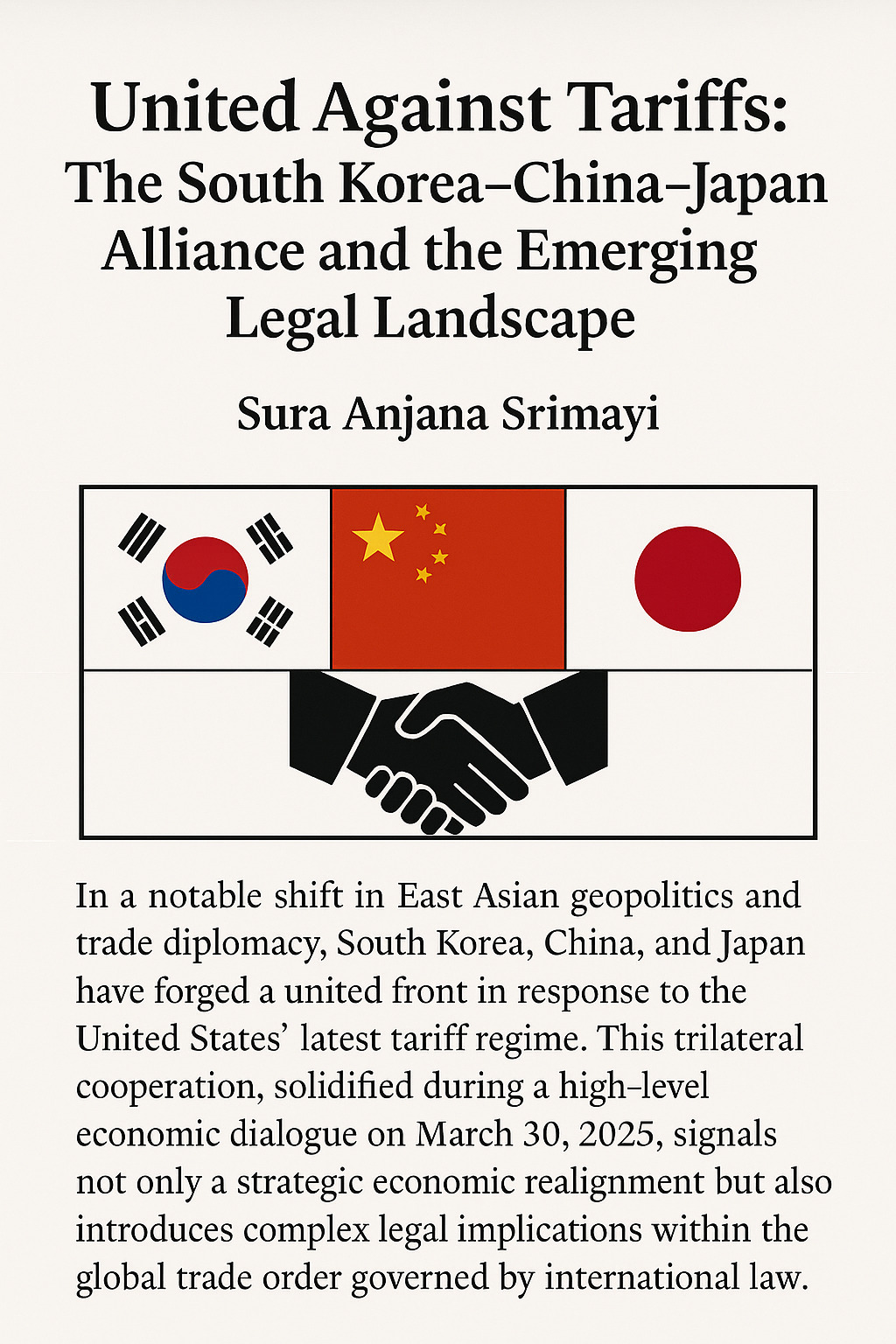View News
United-Against-Tariffs-The-South-Korea-China-Japan-Alliance-and-the-Emerging-Legal-Landscape

United Against Tariffs: The South Korea–China–Japan Alliance and the Emerging Legal Landscape
~ Sura Anjana Srimayi
Introduction
In a notable shift in East Asian geopolitics and trade diplomacy, South Korea, China, and Japan have forged a united front in response to the United States’ latest tariff regime. This trilateral cooperation, solidified during a high-level economic dialogue on March 30, 2025, signals not only a strategic economic realignment but also introduces complex legal implications within the global trade order governed by international law.
Backdrop: US Tariffs as the Catalytic Force
The alliance is a direct reaction to the new “reciprocal tariffs” introduced by the Trump administration—an aggressive trade policy aimed at correcting trade deficits and protecting domestic industries. However, the scale and unilateral nature of these tariffs have alarmed export-driven economies like South Korea, China, and Japan. In response, these three nations—long-standing US trading partners and regional competitors—set aside historical frictions to convene their first trilateral economic dialogue in five years.
Hosted in Seoul, the meeting brought together Trade Ministers Ahn Duk-geun (South Korea), Yoji Muto (Japan), and Wang Wentao (China). What emerged was an unprecedented convergence in East Asian diplomacy, focused on strengthening regional resilience against US protectionism and shaping a collective legal and economic response.
Key Outcomes of the Trilateral Dialogue
1. Coordinated Response to US Tariffs
The three countries pledged to “closely cooperate” in response to the US tariffs. While specific strategies remain undisclosed, potential avenues include:
-
Joint legal action through the World Trade Organization (WTO)
-
Harmonized retaliatory tariffs
-
Strategic diversification of trade partnerships
Legally, this unified stance amplifies their diplomatic leverage and reinforces collective resistance to unilateralism in global trade.
2. Enhanced Supply Chain Resilience
Acknowledging their deep integration in global supply networks, the countries agreed to enhance supply chain stability through:
-
Regional investment promotion
-
Diversification of sourcing and production
-
Possible creation of trilateral standards and dispute resolution mechanisms
Such cooperation, if legally structured, may involve harmonized customs procedures and mutually recognized regulations.
3. Export Controls and Strategic Materials Dialogue
The ministers committed to continued dialogue on export controls, especially concerning technology and critical raw materials. Legal cooperation here may involve:
-
Developing shared principles on export regulation
-
Challenging extraterritorial reach of US laws
-
Creating transparent frameworks to support regional industries
4. Acceleration of Trilateral Free Trade Agreement (FTA) Negotiations
Negotiations for a China–Japan–Korea FTA, ongoing since 2012, received renewed momentum. A finalized agreement could:
-
Eliminate or reduce tariffs and non-tariff barriers
-
Establish unified rules of origin
-
Include intellectual property, investment protection, and dispute resolution clauses
Such an agreement would need to comply with WTO’s Article XXIV of GATT, ensuring no increase in trade barriers against non-members.
5. Advocacy for Multilateralism and Open Trade
The joint communique emphasized support for “regional and international trade,” reaffirming commitment to a multilateral, rules-based global trade order. This includes:
-
Defending WTO norms and procedures
-
Engaging in WTO reform discussions
-
Building alliances with like-minded countries to counter protectionism
Legal Implications and Challenges
1. WTO Dispute Mechanisms
A unified WTO challenge would be stronger both legally and politically. Likely arguments include:
-
Violation of the Most-Favored-Nation (MFN) principle
-
Breaches of bound tariff commitments
-
Improper invocation of national security exceptions
Joint litigation may involve resource sharing and coordinated legal strategy.
2. Legality of Retaliatory Measures
Should coordinated retaliation be pursued, it must be proportional and legally justified. Any retaliatory tariffs must comply with WTO dispute settlement outcomes or authorized suspension of concessions to avoid counterclaims.
3. Supply Chain Prioritization Risks
While regional supply chain cooperation is permissible, preferential treatment that discriminates against third countries may contravene MFN obligations unless justified under permitted exceptions.
4. FTA Compliance with WTO Rules
Any trilateral FTA must meet WTO requirements by:
-
Substantially eliminating tariffs among members
-
Avoiding higher barriers for non-members
-
Ensuring transparent notification and review under WTO frameworks
5. Export Controls and Sovereignty
Although states may impose export controls for national security, overreach or opaque policies may attract legal scrutiny. A harmonized regional approach could improve legal predictability while maintaining compliance with international obligations.
Broader Impact on the Global Trade Order
1. A Rebuttal to Unilateralism
This alliance challenges unilateral tariff policies and reinforces the value of multilateral legal norms in international commerce.
2. Rise of a Regional Economic Bloc
If successful, the trilateral FTA could evolve into a robust East Asian economic bloc, altering global trade flows and reducing reliance on Western markets.
3. Influence on Future Trade Negotiations
The collective stance may serve as a template for other nations seeking to counter unilateralism, potentially shifting global trade negotiation dynamics.
4. Geopolitical Consequences
Although focused on trade, the alliance may affect strategic power balances in the Indo-Pacific, shaping regional diplomacy and security considerations.
Conclusion
The trilateral alliance of South Korea, China, and Japan marks a pivotal development in the evolving landscape of global trade. Their unified reaction to US tariffs—through potential WTO litigation, coordinated economic measures, and reinvigorated FTA talks—signals a sophisticated legal and diplomatic shift. As the alliance navigates complex WTO regulations and broader legal frameworks, its actions could significantly influence the future of multilateralism, regionalism, and the legality of trade practices worldwide. The global community will be watching closely as these nations chart their collective path through the legal terrain of international trade.
"Unlock the Potential of Legal Expertise with LegalMantra.net - Your Trusted Legal Consultancy Partner”
Disclaimer: Every effort has been made to avoid errors or omissions in this material in spite of this, errors may creep in. Any mistake, error or discrepancy noted may be brought to our notice which shall be taken care of in the next edition In no event the author shall be liable for any direct indirect, special or incidental damage resulting from or arising out of or in connection with the use of this information Many sources have been considered including Newspapers, Journals, Bare Acts, Case Materials , Charted Secretary, Research Papers etc.

